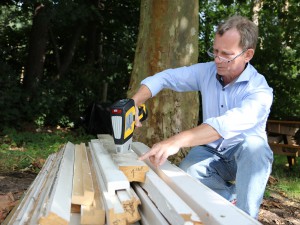Most waste wood today is either used for heating or chipped to produce particle boards. The aim of the EU-funded CaReWood (Cascading Recovered Wood) project is to reuse this secondary raw material several times over – for example in house-building or to make furniture. Fraunhofer researchers have discovered that it is possible to salvage large pieces for wood and recycle them without any loss of quality. The necessary methods for detecting and removing contaminants are being investigated in this project.
There are few materials as versatile as wood. In addition to its qualities as a universal construction material, it can also be reused after serving its original purpose. However, this sort of cascading practice is still the exception in today`s Europe, where most waste wood is either chipped to produce particle boards or incinerated. In some EU countries like France, it is dumped in landfill sites. This practice is forbidden in Germany, where waste wood is generally used as fuel in power-generation plants, but without the intermediate stage of reusing it as a building material or for other purposes.
Upcycling instead of downcycling
It would make more sense to reuse salvaged wood several times over, an approach being investigated in the EU-funded CaReWood or Cascading Recovered Wood project (see box “EU CaReWood project at a glance”). A consortium of 15 project partners in five countries has set out to promote the cascaded use of solid wood in value-added applications that promise to improve the efficiency of the materials cycle.

Physicist using a hand-held X-ray fluorescence to test sections of salvaged window scantlings for the presence of inorganic wood preservatives.
“Other recycling options ought to be considered before incinerating waste wood to produce energy or converting it immediately into chips for particle board production. For example, large quantities of excellent-quality timber can be recovered from building renovation and demolition sites. This even applies to salvaged wood that has been superficially treated with wood preservatives, as we were able to prove in our tests. The challenge is to develop recycling methods that allow old roof beams and other large pieces of timber to be kept intact for further use as building materials,” explains Peter Meinlschmidt, a physicist working at the Fraunhofer Institute for Wood Research WKI. He and his colleagues were tasked with identifying suitable measurement techniques that could be used to detect the presence of contaminants in wood and develop efficient surface cleaning processes.
According to the German Waste Wood Ordinance (Altholz V), waste wood categories A III and A IV are considered as potentially polluted. These types of waste wood may contain traces of plastics such as PVC or remnants of lead-based paints and other products containing heavy metals on their surface, or may be impregnated with hazardous substances such as DDT or PCBs, commonly found in old wood preservatives. For this reason, the law requires them to be incinerated. “But even if their surface might be contaminated, such lignocellulosic materials contain a not insubstantial volume of wood that could be recycled if suitable stripping and sorting processes were available,” says Meinlschmidt.
Removal of heavy metals and wood preservatives
The scientists use several methods, including laser-induced breakdown spectroscopy (LIBS), X-ray fluorescence (XRF), gas chromatography – field asymmetric ion mobility spectrometry (GC-FAIMS) and near-infrared spectroscopy (NIS), to determine whether wood is contaminated, and if so the depth to which the pollutants penetrate and how much surface material must be removed to eliminate them. The first two methods are ideally suited to detecting heavy metals, while the last two help detect traces of organic wood preservatives.

Many of the over 150-year-old posts that support the deck of the world’s longest teak bridge need to be replaced. The recovered wood will be reused to make handrails or rest benches along the footbridge.
The test results show that it is sufficient to remove only a few millimeters of the outer layers. “Whatever the species of wood, and regardless of whether it was treated with wood preservatives or coated with paint or varnish, the recycled timber is free of undesirable substances,” says the researcher. The scientists also tested the bending strength and transversal stress resistance of the recovered wood to determine the mechanical stability of the underlying raw material. They used several different methods to clean the wood surface, including rotating brushes, sand-blasting with different abrasive media, sawmilling and planing. The Fraunhofer WKI researchers conducted their tests on shipping pallets and discarded window frames. “Another point in favor of upcycling is that recovered wood is often of better quality and more mechanically stable than new wood, because trees used to be allowed to grow more slowly than in the commercially managed forests planted in the past decades,” says the physicist.
The partners in the CaReWood project also see their work as a contribution to environmental protection. “Deforestation is on the increase again all over Europe, resulting in a declining availability of primary wood. Germany is an exception, however. Forests of conifers planted in previous decades are being allowed to grow wild, in the hope that this will encourage the return of native beeches – a species better adapted to the vagaries of the climate,” says Meinlschmidt.
Myanmar: New life for bridge support posts
The physicist and his fellow researchers have had an opportunity to demonstrate the environmental benefits of their work in Myanmar, where they are helping with the renovation of the world’s longest teak bridge, the U Bein Bridge. The old posts that support the deck of the bridge, some measuring ten meters in length, are successively being replaced. They will be kept entire and reused as handrails or rest benches along the 1.2-kilometer footbridge.
Meinlschmidt is confident that the trend toward the cascaded use of recovered wood will continue, not only in Germany, and that fewer recyclable materials will be incinerated as the easiest solution. One reason is the current revision of the German Waste Wood Ordinance. The updated version scheduled to enter force in 2018 gives greater emphasis to reclaiming materials for other uses rather than destroying them in incineration plants – a goal shared by the CaReWood project partners.
Source
Fraunhofer-Gesellschaft, press release, 2017-10-02.
Supplier
Bundesministerium für Ernährung und Landwirtschaft (BMEL)
Fachagentur Nachwachsende Rohstoffe e.V. (FNR)
Fraunhofer-Gesellschaft
Fraunhofer-Institut für Holzforschung Wilhelm-Klauditz-Institut WKI
Share
Renewable Carbon News – Daily Newsletter
Subscribe to our daily email newsletter – the world's leading newsletter on renewable materials and chemicals









